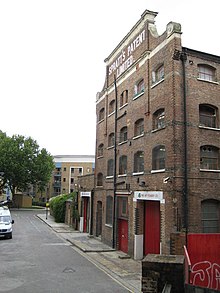Spratt's Complex
The complex, originally Spratt's dog biscuit factory,[2] consists of six multi-storey warehouses made of reinforced concrete grouped around courtyards.
Limehouse Cut was once a series of grain warehouses, along with buildings for meal grinding, sand and grit processing, baking, veterinary medicine and laboratory stores.
Patent House was originally a delivery and grain warehouse, with space for biscuit packing, a blacksmiths and wire workers, saw mills, kennel and box makers, and an advertising department.
[5] Before 1914, the factory made other food for human consumption under the "Poplar" brand, such as pulses (butter beans, lentils, and peas), and did international trade in live animals (horses, foxes, and monkeys).
There was also a dog-show department during this period, possibly owing to James Spratt's initial 14-year-old assistant, the future dog show founder Charles Cruft.
Colman's Wharf was occupied by Gina Plastics until sold for development in 1988, at which time there was a huge industrial bay outside Studio5, on what is now part of the car park.
The space at the canal end of the floors of Colman's Wharf was much larger than now, as there was no interior staircase, nor was the present lift shaft part of the building, as large hoists were in use before its development.
At that time, residents of the building included the Queen's tapestry restorer Ksynia Marko, a packaging firm, Roger Law of Spitting Image, sculptor Michael Green and ceramicist Elizabeth Fritsch.
At the top of Limehouse Cut building is a large 1,500 sq ft (140 m2) communal roof garden with views over Canary Wharf.




